Coffee is something I really used to enjoy. In my memories, that roasted, dark liquid is synonymous with warm cafes, good conversation, and air perfumed with delicious aromas. But now that I’m more than a decade past college, I’m finding that my appreciation for the flavor of this ubiquitous American beverage is quickly being eclipsed by its less-than-desirable side effects.
I don’t like how my hands shake after having just one cup. I don’t like how many resources and fossil fuels are used to get these glossy, dark beans into my coffee press. I don’t like how unethical human labor and pesticides are needed to fuel America’s demand for their daily latte. And I especially don’t like how I started feeling like I needed it in the morning.
So, I decided to start seeking out alternatives for the caffeine-laden cups I had grown to depend on in the morning. In the past, I had enjoyed some roasted barley tea that was rather coffee-like, and the memory piqued my curiosity: Could I create my own roasted beverage from the resources right here on my homestead?
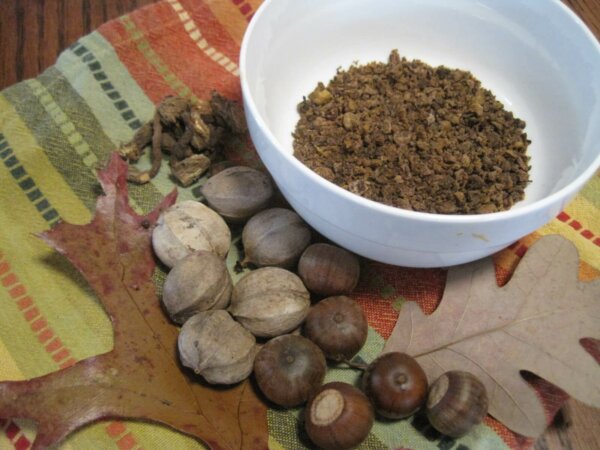
On our homestead, one of the main goals is a desire for self-sufficiency. If we can do it by hand, grow it in our ground, raise it in the pasture, or forage it from the forest instead of buying it, we’re going to, even if it’s not completely “normal.” And in this homesteader’s book, “needing” coffee shipped from the ends of the earth was a red flag that it was time for me to claim responsibility for my morning beverage.
Besides, as I was leafing through my favorite foraging books, I noticed many plants being recommended as coffee substitutes. I glanced out the window at the sunny dandelion blossoms and blue stars of chicory, and I knew that a new adventure was brewing (pun intended).
Foraged Coffee Alternatives
The morning blend that I’ve figured out for our homestead is made of acorns, chicory roots, and dandelion roots, but the variety of plants you could use certainly doesn’t end there. Sources I’ve read also indicate that cleavers seeds, burdock root, beechnuts, Kentucky coffeetree, and sunflower seeds can also be used, but I have yet to experiment with those. Kentucky coffee tree certainly sounds promising, though!
https://www.instagram.com/p/BiXpSoDlG8g/
For those inexperienced with foraging, however, I recommend these three, super common plants. They are easy to identify, don’t have any toxic look-alikes, and are probably in your backyard as we speak. Any of them could be used alone to make coffee, by the way, but, as I’ll explain below, I find the blend of the three makes a truly delightful treat.
Chicory (Root)
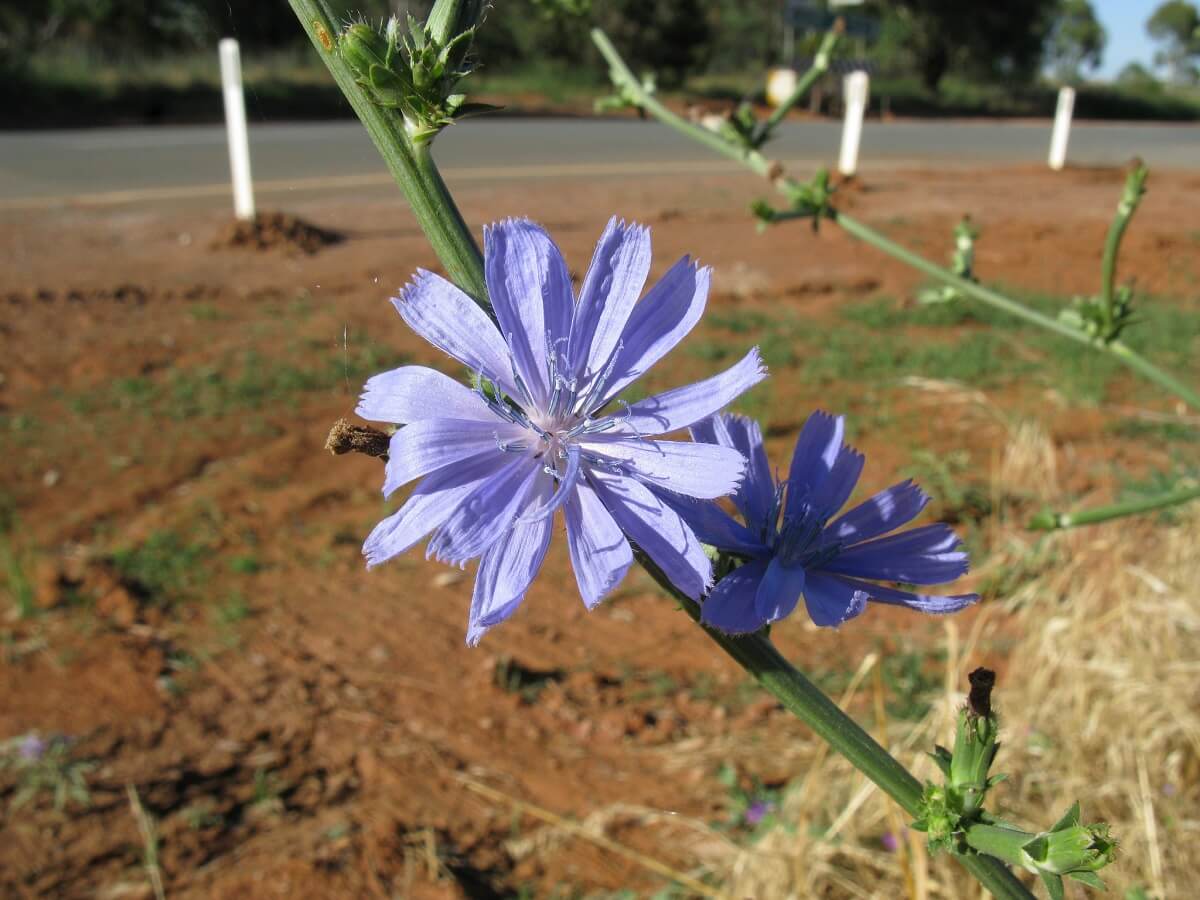
The starry, blue blossoms of chicory are one of my favorite sights along a country road. These plants seem to be fans of growing in the rockiest ground they can find, so I usually plan on digging chicory roots from the edges of our gravel driveway only after a good hard rain.
The twisted, gnarled roots do take quite a bit of scrubbing when harvested wild, so give yourself time to really get them clean before bringing them into the kitchen. The best time to harvest chicory is in the late fall after the tall stalks have stopped flowering for the year.
After thoroughly cleaning the roots, you need to dry them. I prefer to chop them in tiny pieces while fresh, and then dry them on cookie sheets next to my woodstove. Be aware that they shrink considerably while drying, so you’ll want quite a lot of roots if you plan on making a lot of coffee.
Dandelion (Root)
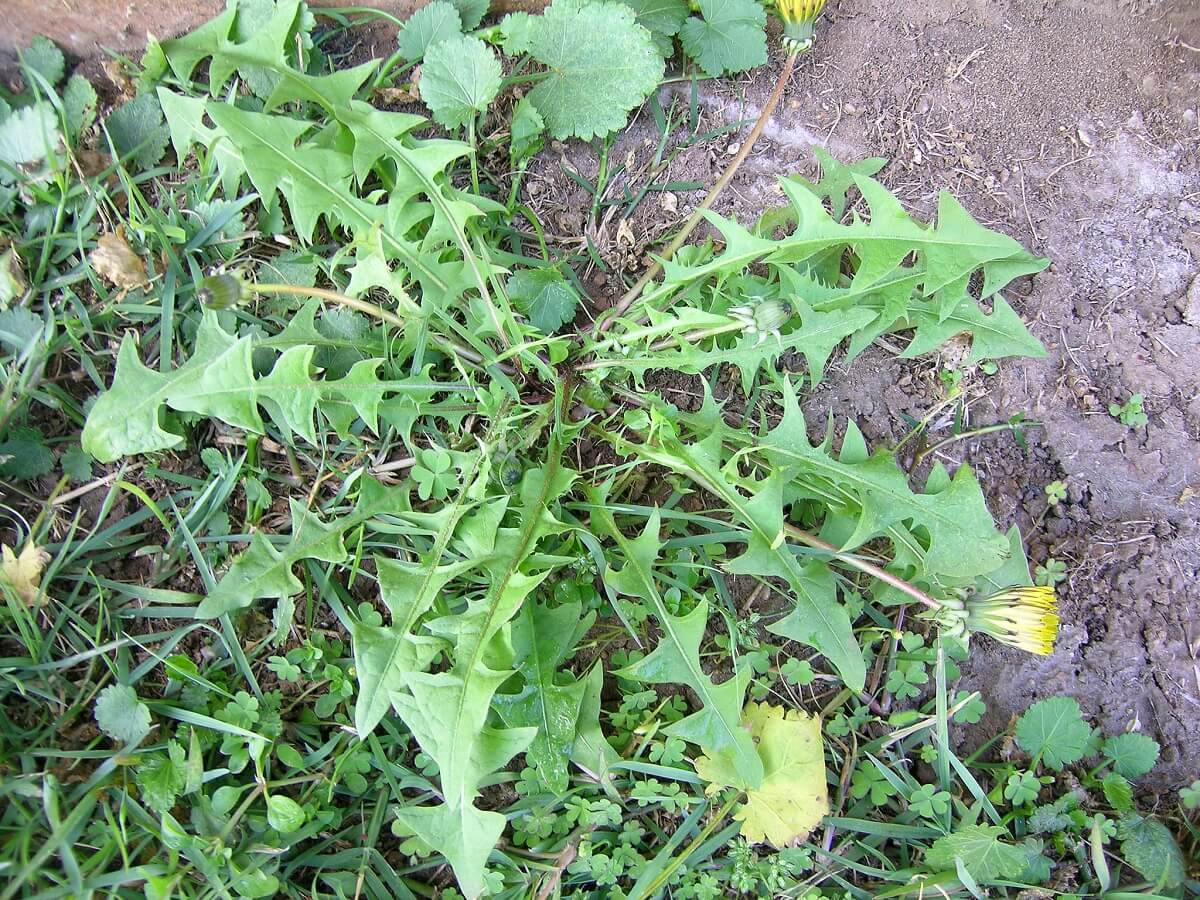
This unmistakably sunny, delightfully useful weed may the scourge of landscapers, but on our homestead, it’s welcome. Though only the deep taproots are used for this recipe, the edible leaves and flowers also make their way to our dinner table! The best time to harvest dandelion roots is in the autumn, winter, or early spring—this is when the roots are their biggest.
As with chicory, you’ll need to wash, chop, and dry the roots to prepare them for roasting. I usually process them together, as I’m usually digging both of them at the same time.
Acorns (Shelled Nuts)
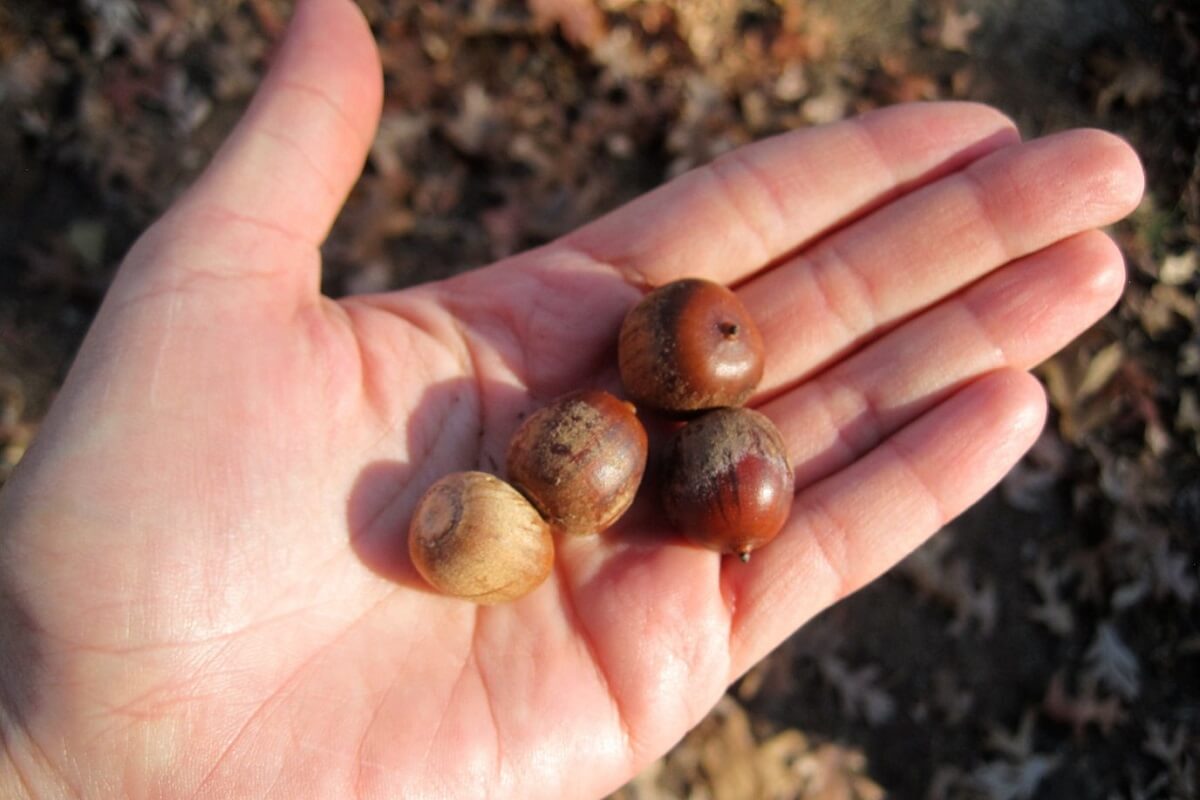
Move over, squirrels, those acorns are good eatin’! If you have access to an oak tree, then you have more free food than you’ll probably know how to use once you know how to make acorn flour. Acorns may be a lot of effort to prepare, but this abundant, free food source is well worth the time.
Preparing acorns for coffee requires you to shell them, then leach the bitter tannins out in several changes of hot water. I take you step by step through the process in great detail in my earlier article on harvesting acorns for food. Thankfully, once you’ve made yourself acorn flour, you can use it for both food and drink! The best time to forage for acorns is in mid-fall, usually after a good windstorm.
Hickory Nuts
Sometimes, I pulverize fresh hickory nuts and add them to the brew once it’s simmering—you don’t need to dry or roast them beforehand, and they add a delightful richness to the final product. Since they come into season at the same time as the acorns and roots, scoop them up if you come across them!
A Note on Foraging
As always, when foraging, use common sense. Don’t forage from the sides of roads, where toxins accumulate, or in public places, where pesticides might be sprayed. Always ask permission before collecting plants on land you don’t own, especially when digging roots, however invasive or common they might be.
Realize that when you’re harvesting roots, you’re destroying the plant, so be courteous. Take as many as you need, but use as many as you take. Follow the forager’s rule of thirds: Take no more than a third of a patch of plants for yourself, leave one third to grow next year’s plants, and the other third for wildlife. Finally, clean up after yourself. Don’t leave gaping holes in the ground, but place topsoil back over the hole and leave it as you found it.
How To Brew Foraged Coffee
It may seem like a lot of work to get to this point, but if all that work was done on sunny fall days, it’s far more enjoyable than it sounds on paper! After all that digging, acorn-sorting, and root washing, it’s time to get some roasty goodness in a cup. Thankfully, the rest of the process takes about 8 minutes.
For this recipe, I mix two parts acorn flour to one part chicory-dandelion root. I find that the nutty, spicy sweetness of the acorns is balanced by the natural, pleasant bitterness of the roots, resulting in a beverage that hits all the familiar coffee places in my mouth.
For a typical 8oz serving, you need 2 tablespoons of any combination of roots or nuts to 8 ounces of water. It may be worth noting that you should anticipate using more roots and nuts than you would tea, but that you can certainly adjust to your own preference after making a few cups.
If you’re making a full french press worth of coffee, I would use about 6-8 tablespoons of “coffee” to 4 cups of water.
Step 1: Grind The Assembled Ingredients.
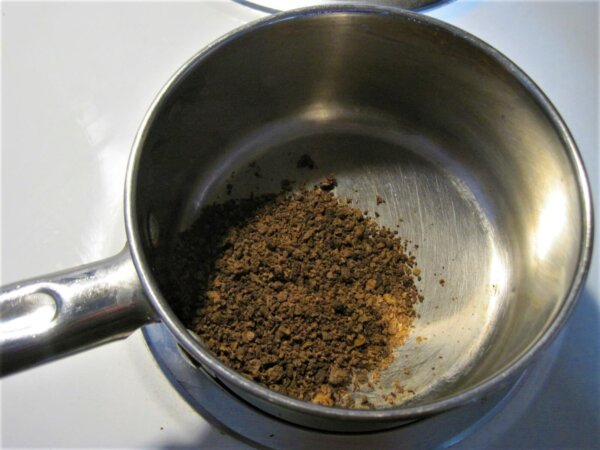
Once you have your dried roots and dried, leached acorns, run them through a coffee grinder to get a more finely ground consistency. Put about 1-2 tablespoons per cup in a stainless-steel or cast-iron saucepan.
2. Roast Until Darkened, but Not Burned
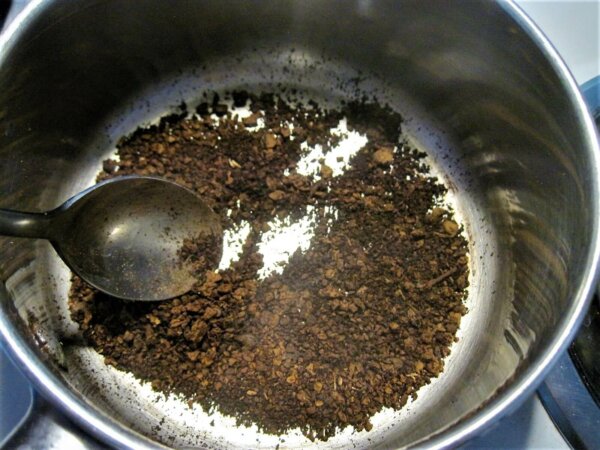
Aside from drinking it, this is my favorite part of the whole process—the caramelly rich, sweet smell of those toasting nuts and roots is out of this world. The first time I made a batch of this, I could hardly believe that it was merely stuff from my backyard!
Put the heat on medium and stir constantly until the grounds achieve a uniform, dark brown—the more you make this, the more you’ll know what degree of roast is best for you. If you want to skip this step, you can also batch-roast all of the roots and nuts in a 400°F oven until done, but then you miss out on the olfactory delight!
3. Add Water (And Stand Back!)
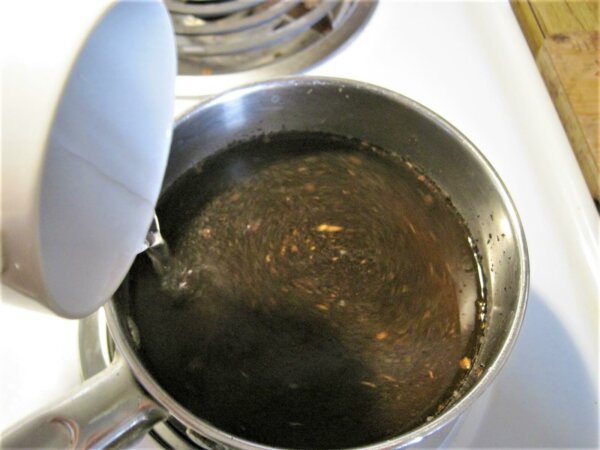
Now, pour in as much water as you need (I usually pre-fill each cup necessary and have it on hand). Be aware that the pan will be very hot from roasting the nuts, so get ready for some steam! Put the heat to low and simmer for 3-7 minutes.
4. Strain
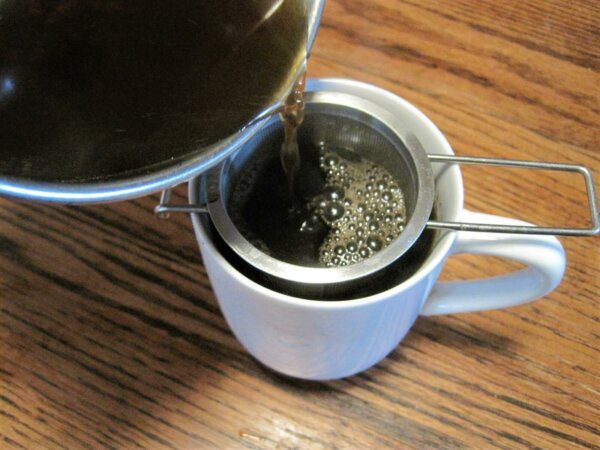
I use reusable tea strainers for this, but a French press or coffee filter will work just fine if you happen to have those instead. Once you filter out the solids, throw them in your compost or toss them to your chickens.
5. Serve!
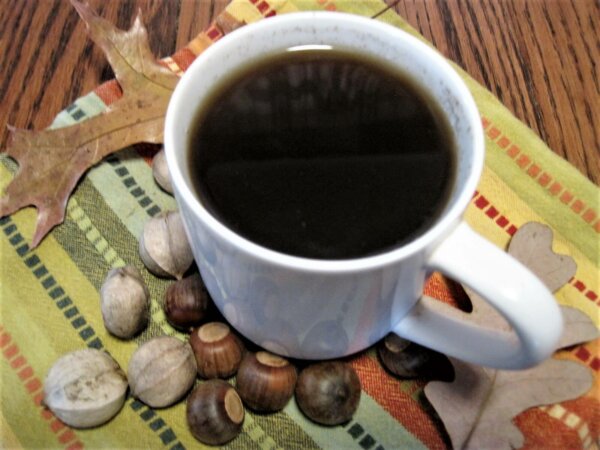
I enjoy my foraged “coffee” both black and, for when I’m feeling extra fancy, accented with cardamom, cinnamon, maple syrup, and milk. Pretty much anything you do with coffee, you can do with this blend … except you can do it at any hour of the day since it’s caffeine free!
Health note: Both chicory and dandelion are diuretic, so be wise with how much you consume before a long car trip!
So … Does How Does It Taste? And Is It Worth All the Trouble?
So, for the coffee-addicted, can this cup pass for a cup of traditional java? It depends on your perspective. I think that wild-foraged coffee alternatives suffer by comparison. Don’t drink these free gifts expecting them to be exactly like coffee … delight in them for being what they are. A homemade, handcrafted drink like this should stand on its own merit, rather than merely being called “poverty coffee” or whatever historical accounts call it.
Is it delicious? Yes. Is it roasty and comforting? Yes. Can you mix milk and sugar and flavored syrups with it to make some cafe-worthy beverage? Yes. So, is it coffee? Of course not. It’s acorn-chicory-dandelion tea-stuff!
But don’t take my word for it. Try it yourself! Maybe you, too, will be able to shirk off the caffeine-fiend addiction and discover your own cup of extremely local, organic, fair-trade, pesticide-free handcrafted brews.
“…I prefer [dandelion root coffee] over coffee, and I suspect that if dandelion were endowed with caffeine and coffee was deprived of this stimulant, the world would drink billions of dollars’ worth of dandelion and the coffee tree would be an unknown component of African highland flora.”
-Samuel Thayer, author of Nature’s Garden
Rather than being a vector for a drug to keep me awake, something like this is nourishing for both the body and spirit and wakes me up in entirely different and better ways because I had to go on an adventure to get it. Tasting a literal bit of my homestead in my favorite mug is far better than forking over a fiver for something in a paper cup.










































Interesting stuff, I just gave up coffee on Boxing Day , so I might try the Dandelion alternative, thanks for the post.
So glad it could be helpful! I’d love to hear how it goes.
Also, if you’re strapped for time and can’t get out to dig (but still want to keep that resolution) I’ve also enjoyed Teaccino dandelion coffee. As a side note, just today I threw a tablespoon of cocoa powder in my morning “coffee,” and it was delightful!
Thanks for your timely article — I’m also coming to the end of years of addiction to caffeine. I’ve quit before, but never had anything to replace the hefty and hearty coffee taste. Maybe this will fill that space — Thanks again,
Diana (georgia.dv)
I’m so glad it can be helpful! I, too, got tired of being addicted to this “acceptable” drug that is so freely distributed. Give yourself time to adjust to it, and I think you’ll be able to keep from going back to coffee. Hope everything goes well!
Hi, I just came across this and have always wanted to live off the grid. Thank you for your inspiration. I am working for a non-profit forest conservation project in Malaysia and we have ‘Human Library’ sessions in the forest where I work (we have an outdoor classroom area for knowledge exchange), where people (who are the books) share their stories. We were wondering if you would like to be the ‘book’ for one of our session? Please do let us know if you are keen to share your experience and inspire more people – I’m sure you are a treasure chest of knowledge. Looking forward to our response:) thank you so much for this.
I’m glad this article could be helpful to you! I checked out your website–it looks like you’re doing some really interesting and important work!
I’m honored to be considered for such a project–but I must admit, I have no knowledge on Malaysian ecosystems and ways of off-grid living on that specific terrain (not to mention, I surely couldn’t make it out to you to teach!). So much of the knowledge that I’ve gotten has come (very recently) from living this lifestyle on this specific piece of land, and I’ve still got so much to learn. I imagine that there are people closer to you –specifically, the elders who know the land around you–who would be far more knowledgeable and wisdom-rich than I am!
However, I would be more than happy to share the many resources I’ve used to help myself learn these skills. Let me know if you’re interested!